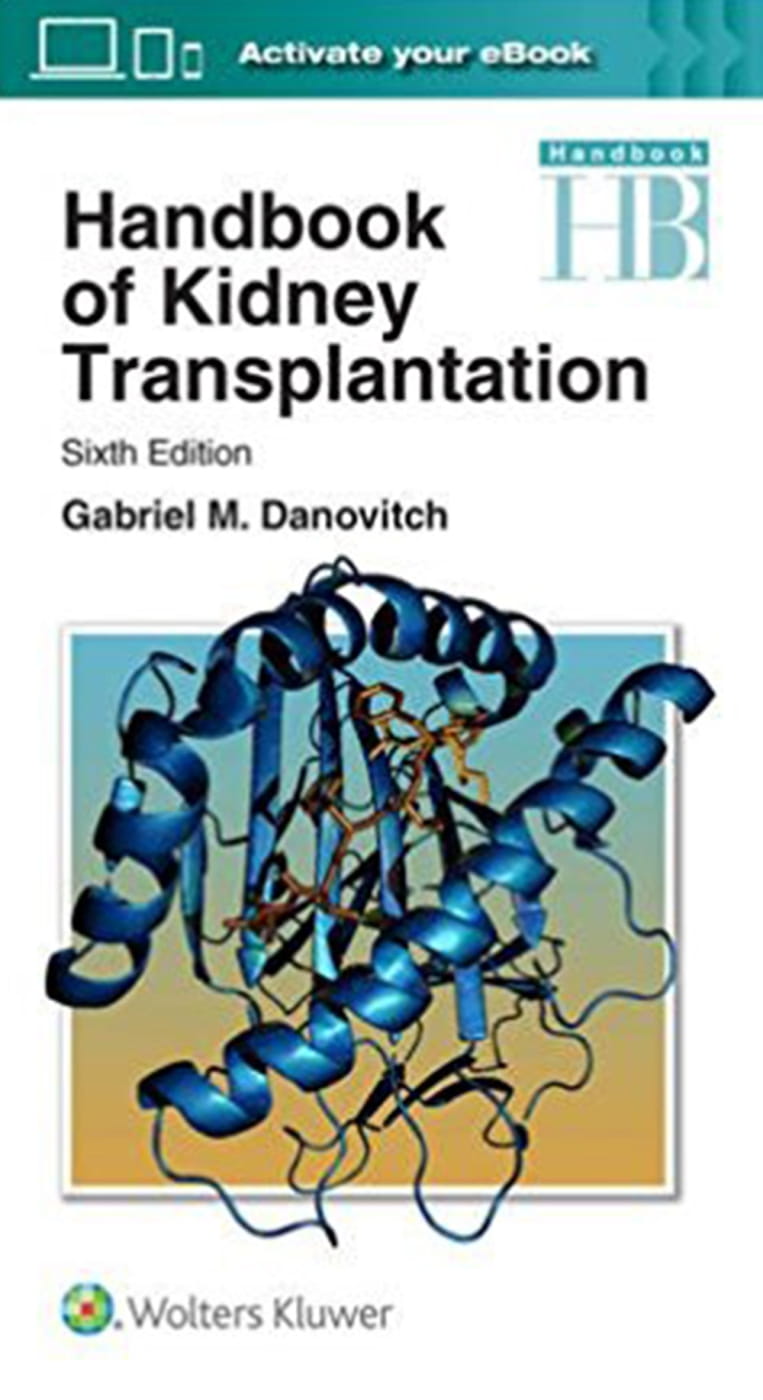- 定價93.00元
-
8
折優惠:HK$74.4

|
|
|
|
Handbook of Kidney Transplantation
|

|

沒有庫存
訂購需時10-14天
|
|
|
|

|
|
9781496326157 | |
|

|
|
Gabriel M. Danovitch | |
|

|
|
九州 | |
|

|
|
2017年6月13日
| |
|

|
|
500.00 元
| |
|

|
|
HK$ 425
|
|
|
|
|

| |
|
|
|
|
| |
|
|
詳
細
資
料
|
ISBN:9781496326157規格:平裝 / 606頁 / 10.9 x 20.1 x 2 cm / 普通級 / 單色印刷 / 6版出版地:美國
|
|
分
類
|
醫療保健 > 疾病百科 > 內科 |
同
類
書
推
薦
|
|
|
內
容
簡
介
|
Concise, readable, practical and well-illustrated, the sixth edition of the Handbook of Kidney Transplantation has been thoroughly updated and revised to reflect the most current knowledge and practice in the field. Ideal for physicians, surgeons, fellows, and nurses who manage kidney transplant patients, it covers everything from treatment options for end-stage renal disease to transplantation, post-operative management and transplant immunology, focusing on every key aspect of the clinical practice of kidney transplantation.
•Includes new chapters on the Allocation of Deceased Donor Organs and Kidney Transplantation in the Developing World, as well as expanded chapters on living donation and immunosuppressive drugs and protocols.
•Outlines the major concerns surrounding renal transplantation and the most successful approaches to problems arising in short-term and long-term patient care.
•Covers immunobiology and immunosuppression, as well as surgery, histocompatibility, and short and long-term follow-up.
Your book purchase includes a complimentary download of the enhanced eBook for iOS, Android, PC & Mac.
Take advantage of these practical features that will improve your eBook experience:
•The ability to download the eBook on multiple devices at one time — providing a seamless reading experience online or offline
•Powerful search tools and smart navigation cross-links that allow you to search within this book, or across your entire library of VitalSource eBooks
•Multiple viewing options that enable you to scale images and text to any size without losing page clarity as well as responsive design
•The ability to highlight text and add notes with one click
?
|
|
目
錄
|
Chapter 1? Options for Patients with Advanced Kidney Disease
Chapter 2? Transplantation Immunobiology
Chapter 3? Histocompatibility Testing, Crossmatching, Immune Monitoring
Chapter 4? The Science of Deceased Donor Kidney Transplantation
Chapter 5? Allocation of Deceased Donor Kidneys
Chapter 6? Immunosuppressive Medications and Protocols for Kidney Transplantation
Chapter 7? Living Donor Kidney Transplantation
Chapter 8? Evaluation of Adult kidney Transplant Candidates
Chapter 9? The Transplant Operation and Its Surgical Complications
Chapter 10? Post-Transplant: The First 3 Months
Chapter 11? Post-Transplant Long-Term Management and Complications
Chapter 12? Infections in Kidney Transplantation
Chapter 13? Kidney Transplantation and Liver Disease
Chapter 14? Diagnostic Imaging in kidney Transplantation, and Biopsy Technique
Chapter 15? Histopathology of Kidney Transplantation
Chapter 16? Options for the Diabetic Kidney Transplant Candidate
Chapter 17? Kidney Transplantation in Children
Chapter 18? Psychiatric Aspects of Kidney Transplantation
Chapter 19? Organ Transplant Law and Ethics
Chapter 20? Nutrition in Kidney Transplant Candidates
Chapter 21? Psychosocial and Financial Aspects of Kidney Transplantation
Chapter 22? Kidney Transplantation in the Developing World
Chapter 23? The Declaration of Istanbulon Organ Trafficking and Transplant Tourism
Index
?
|
|
序
|
序
The modern era of transplantation can be said to have begun with two momentous events in the 1950s. In 1953, Peter Medawar and his Colleagues at University College London described actively acquired immunologic tolerance in rats, thus heralding the science of transplant immunology and an ongoing search for a similar, reproducible phenomenon in humans. The modern era of clinical transplantation began on December 23, 1951, when Joseph Murray and his colleagues at Harvard performed the first kidney transplantation between identical twin brothers. Both of these pioneers were rewarded with the Nobel Prize for their contribution. In many ways, the promise of these discoveries has been fulfilled in the over 60 years that have followed. The mere fact that organ transplantation is the subject of a handbook series such as this reflects the extent to which it has become normative medical practice. Hundreds of thousands of lives have been saved, and quality years have replaced years of suffering. Our understanding of the complex immunobiology of the immune response has advanced and has brought widespread benefits well beyond the field of organ transplantation. A broad armamentarium of immunosuppressive medications is now available, and innovative surgical techniques serve to expand the donor pool and minimize morbidity. National and international organ-sharing organizations are an accepted part of the medical landscape of the development world.
|
|
|
書
評
|
|
|
|
|

